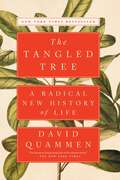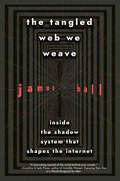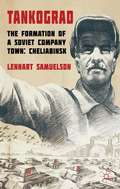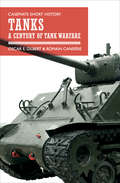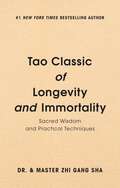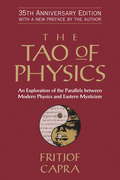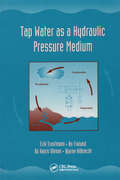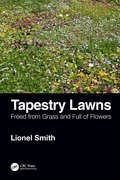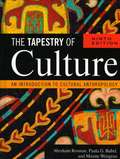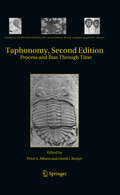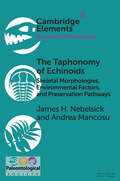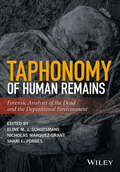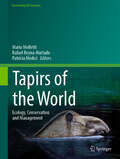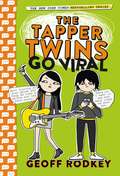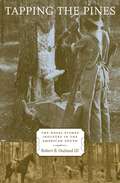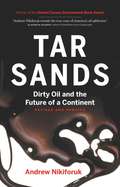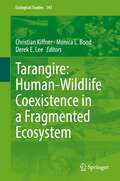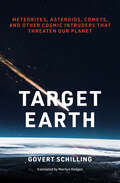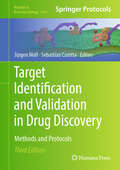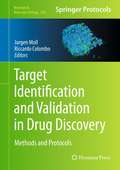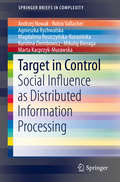- Table View
- List View
The Tangled Tree: A Radical New History of Life
by David QuammenNonpareil science writer David Quammen explains how recent discoveries in molecular biology can change our understanding of evolution and life’s history, with powerful implications for human health and even our own human nature. In the mid-1970s, scientists began using DNA sequences to reexamine the history of all life. Perhaps the most startling discovery to come out of this new field—the study of life’s diversity and relatedness at the molecular level—is horizontal gene transfer (HGT), or the movement of genes across species lines. <P><P>It turns out that HGT has been widespread and important. For instance, we now know that roughly eight percent of the human genome arrived not through traditional inheritance from directly ancestral forms, but sideways by viral infection—a type of HGT. In The Tangled Tree David Quammen, “one of that rare breed of science journalists who blends exploration with a talent for synthesis and storytelling” (Nature), chronicles these discoveries through the lives of the researchers who made them—such as Carl Woese, the most important little-known biologist of the twentieth century; Lynn Margulis, the notorious maverick whose wild ideas about “mosaic” creatures proved to be true; and Tsutomu Wantanabe, who discovered that the scourge of antibiotic-resistant bacteria is a direct result of horizontal gene transfer, bringing the deep study of genome histories to bear on a global crisis in public health. <P><P>“Quammen is no ordinary writer. He is simply astonishing, one of that rare class of writer gifted with verve, ingenuity, humor, guts, and great heart” (Elle). Now, in The Tangled Tree, he explains how molecular studies of evolution have brought startling recognitions about the tangled tree of life—including where we humans fit upon it. Thanks to new technologies such as CRISPR, we now have the ability to alter even our genetic composition—through sideways insertions, as nature has long been doing. The Tangled Tree is a brilliant guide to our transformed understanding of evolution, of life’s history, and of our own human nature. <P><b>A New York Times Bestseller</b>
The Tangled Web We Weave: Inside The Shadow System That Shapes the Internet
by James BallWe all see what the internet does and increasingly don't like it, but do we know how and more importantly who makes it work that way? That's where the real power lays... <P><P>The internet was supposed to be a thing of revolutions. As that dream curdles, there is no shortage of villains to blame--from tech giants to Russian bot farms. But what if the problem is not an issue of bad actors ruining a good thing? What if the hazards of the internet are built into the system itself? <P><P>That's what journalist James Ball argues as he takes us to the root of the problem, from the very establishment of the internet's earliest protocols to the cables that wire it together. He shows us how the seemingly abstract and pervasive phenomenon is built on a very real set of materials and rules that are owned, financed, designed and regulated by very real people. <P><P>In this urgent and necessary book, Ball reveals that the internet is not a neutral force but a massive infrastructure that reflects the society that created it. And making it work for--and not against--us must be an endeavor of the people as well.
Tankograd
by Lennart SamuelsonA major production site of Soviet KV and T-34 tanks in WWII, the town of Cheliabinsk in the Urals was nicknamed 'Tankograd', its civilian machine-building factories swiftly converted to arms production. This book gives a social, economic and political panorama that describes everyday life in a typical Soviet company town during the Stalin era.
Tanks: A Century of Tank Warfare (Casemate Short History)
by Oscar E. Gilbert Romain V. Cansière&“For all the history buffs on warfare of the last century, Tanks is a perfect choice . . . packed with fascinating information&” (San Francisco Book Review). This Casemate Short History—by the authors of Tanks in Hell: A Marine Corps Tank Company on Tarawa—provides an informative and entertaining introduction to this iconic weapon of the last hundred years. Tanks first ventured into battle on the Somme in 1916, and by the end of the war, countries were beginning to choose &“heavy&” or &“light&” tank designs to suit their preferred doctrine. Design then stagnated until World War II brought about rapid change. Tanks would prove integral to fighting in almost every theater; the Germans swept across Europe using tanks to spearhead their blitzkrieg method of war, until Soviet tanks proved more than their match and led to some epic tank battles on a huge scale. After World War II, tank designs became increasingly sophisticated and armor undertook a variety of roles in conflicts, with mixed results. American armor in Korea was soon forced into an infantry support role, which it reprised in Vietnam, while Soviet armor was defeated in guerrilla warfare in Afghanistan. However, tanks played a pivotal role in the American &“shock and awe&” doctrine in two wars in Iraq, and tanks remain a crucial weapons system on the battlefield. &“Comprehensive despite its conciseness. For example, it addresses the employment of tanks in lesser-known conflicts such as the Indio-Pakistani and Sino-Vietnamese wars. The book provides context for contemporary tank operations and offers a perspective on the way ahead.&” —Military Review
Tao Classic of Longevity and Immortality: Sacred Wisdom and Practical Techniques
by Zhi Gang ShaWe all want long, healthy, happy, and productive lives. What are the spiritual principles and ancient wisdoms needed to achieve this? A Tao Grandmaster distills the essential knowledge from thousands of years of sages and introduces powerful new insights and accessible practices to help you achieve longevity and even move in the direction of immortality, while never losing sight of the true purpose of our existence. How can longevity be best attained? Is immortality possible? What is the true reason we should want longevity, and even to strive for immortality? How can we do it? The spiritual principles and practical techniques from thousands of years of ancient wisdom, together with powerful new insights and a "how to" practice that will actually yield results, are distilled into this book. Very few will actually attain immortality, but in following the principles and practices in this book, every aspect of life will benefit.
The Tao of Cosmos: The Holographic Unity of Heaven, Earth, and Humankind
by Zhen G. Ma• Connects the philosophy of the I Ching with key recent advances in cosmology, such as the Big Bang theory, Roger Penrose's cyclic conformal cosmology, and his and Stuart Hameroff's cosmic quantum brain dynamics• Explains the Taoist cosmology of Heaven-Humanity Oneness in the context of Teilhard de Chardin&’s evolutionism, Thomas Berry&’s cosmogenetic trinity, and Brian Swimme&’s 12 cosmological powers• Examines the holographic unity of Heaven, Earth, and Humankind at microcosmic, mesocosmic, and macrocosmic scalesIs the universe inert and empty, or is it in some way responsive to consciousness? Breathing new life into a question that has perplexed philosophers since ancient times and scientists for the last century, physicist Zhen G. Ma, Ph.D., offers a quantitative &“theory of everything&” that beautifully integrates ancient I Ching philosophy, Eastern Taoism, modern cosmology, and the quantum brain dynamics of consciousness. Sharing insights from his years of research on space physics and black-hole spacetime—complemented by studies in quantum brain dynamics and cosmological powers with Brian Swimme at the California Institute of Integral Studies—Ma explains how his integrated theory draws primarily on two key paradigms in the philosophy of cosmology and consciousness: Swimme&’s cosmic creation story of the universe as a green dragon and Roger Penrose and Stuart Hameroff&’s cosmic consciousness.Extending these theories further, Ma shows how they harmonize not only with the ancient Eastern philosophy of the oneness of heaven and humanity, but also with a holographic cosmic principle that connects the quantum-plasma brain with the universe and earth with heaven. He then looks at this holographic unity in the cyclic process of birth, growth, decay, and death and shows how it resonates with Einstein-Friedmann&’s cosmological dynamics and Hawking-Penrose&’s quantum gravity model.Demonstrating a quantitative paradigm of everything, Ma shows how humanity is inextricably and holistically blended into the cosmic fabric of the universe.
The Tao of Physics: An Exploration of the Parallels between Modern Physics and Eastern Mysticism
by Fritjof CapraHere is the book that brought the mystical implications of subatomic physics to popular consciousness for the very first time--way back in 1975. Many books have been written in the ensuing years about the connections between quantum theory and the ideas of Buddhism, Hinduism, and Taoism, but Fritjof Capra's Tao of Physics serves as the foundation on which the others have been built, and its wisdom has stood the test of time. Its publication in more than twenty-three languages stands as testimony to its universal applicability, and its astonishing three and a half decades of strong sales to its enduring significance. This special edition celebrates the thirty-fifth anniversary of this early Shambhala best seller that has gone on to become a true classic. It includes a fresh cover design and a new preface by the author reflecting on further discoveries and developments in the years since the book's original publication."Physicists do not need mysticism," Dr. Capra says, "and mystics do not need physics, but humanity needs both." It's a message of timeless importance.
The Tao of Physics: An Exploration of the Parallels Between Modern Physics and Eastern Mysticism
by Fritjof CapraThis book aims at improving the image of science by showing that there is an essential harmony between the spirit of Eastern wisdom and Western science. It attempts to suggest that modern physics goes far beyond technology, that the way-- or Tao--of physics can be a path with a heart, a way to spiritual knowledge and self-realization.
Tap Water as a Hydraulic Pressure Medium
by Erik Trostmann"Showcases the beneftis and potential advantages of water hydraulics over oil-based media. Interweaves examples and excercises throughout the text to illustrate critical concepts, with helpful appendices on abbreviations, symbols, conversion factors, and water contaminants, and glossary sections."
Tapestry Lawns: Freed from Grass and Full of Flowers
by Lionel SmithSwathes of the human world are covered in ornamental grass lawns; they are the single most commonly encountered horticultural feature on the planet. Unfortunately, they are now often viewed as resource-draining green deserts due to the lack of plant and animal diversity, the need for frequent mowing and watering, and addition of lawn greening products to keep them looking at their best. It is a venerable horticultural feature that is essentially frozen in time, and with few alternatives to whet the appetite, the lawn has languished in its current grass-only format for decades. Until now. Tapestry lawns are a new, practically researched and timely development of the ornamental lawn format that integrates both horticultural practice and ecological science and re-determines the potential of a lawn. Mown barely a handful of times a year and with no need for fertilisers or scarifying, tapestry lawns are substantially richer in their diversity of plant and animal life compared to traditional grass-only lawns and see the return of flowers and colour to a format from which they are usually purposefully excluded. Tapestry Lawns: Freed from Grass and Full of Flowers traces the changes in the lawn format from its origins to the modern day and offers information on how and why the tapestry lawn construct is now achievable. It provides guidance on how to create and maintain a tapestry lawn of your own and champions the potential benefits for wildlife that can follow. Features Accessible and informative to all types of readers from academic to amateur Includes a refined and tested set of useful tapestry lawn plants Contains step-by-step instructions for creation and management methods of grass-free lawns Illustrated in full colour If you have ever thought about mowing your lawn much less, making it much more colourful and wildlife friendly, then this book will inform and guide you to create a perfect, grass-free lawn.
The Tapestry Of Culture: An Introduction To Cultural Anthropology (Ninth Edition)
by Abraham Rosman Paula G. Rubel Maxine K. Weisgrau<P>The most exciting thing about anthropology is that it enables the student to become acquainted with people of different cultures. <P>The Tapestry of Culture provides the student with the basic concepts necessary to understand these different cultures while showing that cultural variations occur within certain limits. <P>Though the forces of globalization have caused cultures of the world around us to become increasingly similar, the book shows that people nevertheless cling to ethnic identities, and their cultural distinctiveness.
Taphonomy
by David J. Bottjer Peter A. AllisonTaphonomic bias is a pervasive feature of the fossil record. A pressing concern, however, is the extent to which taphonomic processes have varied through the ages. It is one thing to work with a biased data set and quite another to work with a bias that has changed with time. This book includes work from both new and established researchers who are using laboratory, field and data-base techniques to characterise and quantify the temporal and spatial variation in taphonomic bias. It may not provide all the answers but it will at least shed light on the right questions.
The Taphonomy of Echinoids: Skeletal Morphologies, Environmental Factors and Preservation Pathways (Elements of Paleontology)
by James H. Nebelsick Andrea MancosuThe study of echinoid evolution, diversity, and ecology has always suffered from the fact that they are represented by taxa showing widely differing architectural designs of their multi-plated skeletons, inhabiting a large range of marine paleoenvironments, which result in highly varying taphonomic biases dictating their presence and recognition. This Element addresses the taphonomy of echinoids and includes: a general introduction to the morphological features of echinoids that play a role in their preservation; a review of processes which play an important role in the differential preservation of both regular and irregular echinoids including predation and transport; a summary of taphonomic pathways included in actualistic studies for recent sea urchins and then reconstructed for fossil taxa; and finally, a case study of the variation of echinoid taphonomy across a shelf gradient using the rich Miocene echinoid fauna of Sardinia.
Taphonomy of Human Remains: Forensic Analysis of the Dead and the Depositional Environment
by Eline M.J. Schotsmans Nicholas Márquez-Grant Shari L. ForbesA truly interdisciplinary approach to this core subject within Forensic Science Combines essential theory with practical crime scene work Includes case studies Applicable to all time periods so has relevance for conventional archaeology, prehistory and anthropology Combines points of view from both established practitioners and young researchers to ensure relevance
Tapirs of the World: Ecology, Conservation and Management (Fascinating Life Sciences)
by Mario Melletti Rafael Reyna-Hurtado Patrícia MediciThis beautifully illustrated book is the first comprehensive work ever published on all four tapir species worldwide, filling a gap in the scientific literature. The book provides information on the systematics, phylogeny, evolution, ecology, conservation, and management of all tapir species. This volume is aimed at a wide range of readers, including researchers, wildlife managers, zoologists, conservation biologists, ecologists, veterinarians, zoo staff, students and environmental policy makers.
The Tapper Twins Go Viral (The Tapper Twins #4)
by Geoff RodkeyTold as a series of interviews, photos, texts, social media hits, and videogame screenshots, The Tapper Twins Go Viral is a laugh-a-page book with a serious lesson: never feed the internet trolls! Claudia Tapper just doesn't get it: How is it possible that the video of the best breakup song she's ever written is watched by virtually nobody, when her brother Reese's completely moronic 2-second clip of an video game wipeout ends up being the hottest thing online at Culvert Prep? Unfortunately, Claudia's bold declaration of injustice sets the stage for the bet of her life: Which of the Tapper twins can get more online followers in a week? She had better top Reese's rapidly escalating popularity or she can kiss her social life goodbye if she loses the bet and is forced to post the most embarrassing video imaginable!
Tapping the Pines: The Naval Stores Industry in the American South
by Robert B. Outland IIIThe extraction of raw turpentine and tar from the southern longleaf pine -- along with the manufacture of derivative products such as spirits of turpentine and rosin -- constitutes what was once the largest industry in North Carolina and one of the most important in the South: naval stores production. In a pathbreaking study that seamlessly weaves together business, environmental, labor, and social history, Robert B. Outland III offers the first complete account of this sizable though little-understood sector of the southern economy. Outland traces the South's naval stores industry from its colonial origins to the mid-twentieth century, when it was supplanted by the rising chemicals industry. A horror for workers and a scourge to the Southeast's pine forests, the methods and consequences of this expansive enterprise remained virtually unchanged for more than two centuries.An important part of the timber products trade, naval stores were originally used primarily in shipbuilding and maintenance. Over the course of the nineteenth century, these products came to be used in myriad ways -- including in the manufacture of paint thinner, soap, and a widely popular lamp oil -- and demand soared. In response, North Carolina producers enlarged their operations and expanded throughout the Southeast, especially into Georgia and Florida, but the short-term economic development they initiated ultimately contributed to long-term underdevelopment.Outland vividly describes the primitive harvest and production methods that eventually destroyed the very trees the trade relied upon, forcing operators to relocate every few years. He introduces the many different people involved in the industry, from the wealthy owner to the powerless worker, and explores the reliance on forced labor -- slavery before the Civil War and afterwards debt peonage and convict leasing. He demonstrates how the isolated forest environment created harsh working and living conditions, making the life of a turpentine hand and his family exceedingly difficult. With an exacting attention to detail and exhaustive research, Outland offers not only the first definitive history of the naval stores industry but also a fresh interpretation of the socioeconomic development of the piney woods South. Tapping the Pines is an essential volume for anyone interested in the region.
Taproots - Underlying Principles of Milton Erickson's Therapy and Hypnosis
by William Hudson O'HanlonThe author, who knew Ericson, makes since of Ericson's work and style for other psychologists and persons interested in incorporating Ericsonian techniques into therapy. Proposes a framework for understanding Ericson. Many case studies are provided.
Tar Sands
by Andrew NikiforukTar Sands critically examines the frenzied development in the Canadian tar sands and the far-reaching implications for all of North America. Bitumen, the sticky stuff that ancients used to glue the Tower of Babel together, is the world's most expensive hydrocarbon. This difficult-to-find resource has made Canada the number-one supplier of oil to the United States, and every major oil company now owns a lease in the Alberta tar sands. The region has become a global Deadwood, complete with rapturous engineers, cut-throat cocaine dealers, Muslim extremists, and a huge population of homeless individuals.In this award-winning book, a Canadian bestseller, journalist Andrew Nikiforuk exposes the disastrous environmental, social, and political costs of the tar sands, arguing forcefully for change. This updated edition includes new chapters on the most energy-inefficient tar sands projects (the steam plants), as well as new material on the controversial carbon cemeteries and nuclear proposals to accelerate bitumen production.
Tarangire: Human-Wildlife Coexistence in a Fragmented Ecosystem (Ecological Studies #243)
by Christian Kiffner Monica L. Bond Derek E. LeeThis edited volume summarizes multidisciplinary work on wildlife conservation in the Tarangire Ecosystem of northern Tanzania. By drawing together human-centered, wildlife-centered, and interdisciplinary research, this book contributes to furthering our understanding of the often complex mechanisms underlying human-wildlife interactions in dynamic landscapes. By synthesizing the wealth of knowledge generated by anthropologists, ecologists, conservationists, entrepreneurs, geographers, sociologists, and zoologists over the last decades, this book also highlights practicable and locally adapted solutions for shaping human-wildlife interactions towards coexistence. Readers will discover the reciprocal and often unexpected direct and indirect dynamics between people and wildlife. While boundaries (e.g. between people and wildlife, between protected and un-protected areas, and between different groups of people) are a common theme throughout the different chapters, this book stresses the commonalities, links, and synergies between seemingly disparate disciplines, opinions, and conservation approaches. The chapters are divided into clear sections, such as the human dimension, the wildlife dimension and human-wildlife interactions, representing a detailed summary of anthropological, ecological, and interdisciplinary research projects that have been conducted in the Tarangire Ecosystem over the last decades. Beyond, this work contributes to the debate about land-sharing versus land-sparing and provides an in-depth case study for understanding the complexities associated with human-wildlife coexistence in one of the few remaining ecosystems that supports migratory populations of large mammals. The topic of this book is particularly relevant for students, scholars, and practitioners who are interested in reconciling the needs of human populations with those of the environment in general and large mammal populations in particular.
Taranto 1940: 'A Glorious Episode'
by A. J. SmithersIn the long history of the British Isles few years can stand in comparison with 1940 in terms of unrivalled gloom. The fiasco in Norway, the evacuation of the BEF from Dunkirk, the fall of France and the entry of Italy into the war were hardly offset by the success of the Royal Air Force in the Battle of Britain and the failure of the Italian troops in their attempted invasion of Egypt. Near the end of the year, however, there occurred an event which is remarkable not only for its dramatic effect on the course of the war but for the fact that it has virtually disappeared from public memory. This was the sinking of the better part of the Italian Fleet in Taranto harbour which, at one stroke, gave the Royal Navy control of the Eastern Mediterranean, somewhat ironically referred to by the Italians as Mare Nostrum. Perhaps even more remarkable, as A.J. Smithers describes in this book, enlivened as always and as critics have frequently remarked, by his mordant wit and extraordinary breadth of knowledge, was the means by which this feat was achieved In November, 1940, the areal torpedo was in its infancy, while its carrier, the Swordfish, known as the 'Stringbag', looked more like something left over from the previous war. But, flying at night and against all the odds, the pilots and observed achieved their objective and with one mighty stroke totally altered the balance of maritime power in the Mediterranean, at last for the foreseeable future.
Target Earth: Meteorites, Asteroids, Comets, and Other Cosmic Intruders That Threaten Our Planet
by Govert SchillingAn acclaimed science writer tells the story of cosmic projectiles that may be on a collision course with our Earth.The impact of an asteroid led to the extinction of the dinosaurs. Could another giant cosmic missile soon be heading our way? In Target Earth, acclaimed Dutch astronomy writer Govert Schilling provides a full account of what we know, and need to know, about all the extraterrestrial matter constantly bombarding our planet—from microscopic dust particles and space debris to massive meteorites, comets, and asteroids.Drawing on the latest scientific discoveries, Schilling explores virtually every aspect of cosmic impacts—from small meteorites to devastating collisions, from the craters that mark our planet&’s surface to the impacts that left their mark on other celestial bodies, and from searches for near-miss lumps of rock to ways of protecting humanity from an assault from the cosmos. Along the way, he considers near misses in the past and the possibility of others in the future and ponders the positive side of these visitations from space: If our planet had not been the target of cosmic rubble from its very formation, life on Earth would likely never have gotten started.
Target Identification and Validation in Drug Discovery: Methods and Protocols (Methods in Molecular Biology #2905)
by Jürgen Moll Sebastian CarottaThis third edition book explores breakthrough techniques in the field of drug target identification and validation. With technologies and methodologies ranging from target identification to the analysis of clinical samples, as well as newer areas like artificial intelligence and machine learning applications, the book will aid decision-makers in drug development by offering a succinct overview of the available technologies for portfolio management. Written for the highly successful Methods in Molecular Biology series, chapters include introductions to their respective topics, lists of the necessary materials and reagents, step-by-step and readily reproducible laboratory protocols, and tips on troubleshooting and avoiding known pitfalls. Authoritative and up-to-date, Target Identification and Validation in Drug Discovery: Methods and Protocols, Third Edition will help a diverse audience of scientists find valuable insights to address their drug development inquiries.
Target Identification and Validation in Drug Discovery
by Jurgen Moll Riccardo ColomboThe major reason for the elevated costs of drug development in the pharmaceutical industry is the high attrition rate. In Target Identification and Validation in Drug Discovery: Methods and Protocols, expert researchers in the field detail many of the methods which are now commonly used to identify and validate new target. These include methods and approaches covering biochemical, cell based, in vivo models and translational methods. Chapters also include selected case reports that demonstrate the integration of these technologies to real life experiences and to demonstrate the multiple use of more than one technology to increase knowledge on a specific target. These Written in the highly successful Methods in Molecular BiologyTM series format, the chapters include the kind of detailed description and implementation advice that is crucial for getting optimal results in the laboratory. Thorough and intuitive, Target Identification and Validation in Drug Discovery: Methods and Protocols contains a comprehensive list of essential methods and clear protocols to follow.
Target in Control: Social Influence as Distributed Information Processing (SpringerBriefs in Complexity)
by Robin R. Vallacher Agnieszka Rychwalska Magdalena Roszczyńska-Kurasińska Karolina Ziembowicz Marta Kacprzyk-Murawska Andrzej K. Nowak Mikolaj BiesagaThis concise monograph introduces and examines social influence from the perspective of the so-called target, rather than from the source, thus providing for the first time a bidirectional account of this pervasive social phenomenon, further bridging simple micro-level dyadic interaction rules with macro-level properties of the (social) system. This integrative approach allows for advanced models of influence to be developed in both the social and natural sciences (e.g. social animals). In particular, when used to investigate emergent properties of social change, this approach shows that social transitions occur as “bubbles of new” in the “sea of old.” While in the traditional view influence is synonymous with achieving power and control over others, the present approach to social influence puts the emphasis on the target’s motives and strategies. Here, the target may actively seek out influence to help forge opinions and achieve guidance regarding courses of action. In this process, the target observes others, models their thought and behavior, and asks for information and opinions. In this broadened perspective, the processes of social influence enables those being influenced (the targets) to use the knowledge and processing capacity of influence sources to maximize their access to information, minimize their processing effort, while optimizing their own functioning and that of the social system in which they evolve. This short text addresses above all scientists interested in social influence in the fields of psychology, sociology, economy, marketing, and biology. However, also researchers interested in modeling social processes, especially opinion dynamics and social change, such as computer scientists, physicists and applied mathematicians will benefit from the insights provided.
